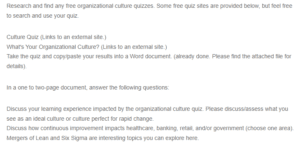Organizational Culture Analysis
The Impact of Organizational Culture Quiz on My Learning Experience
The results of the organizational culture quiz indicate that our organization has established values that create the foundation for the corporate culture based on what employees expect from leaders and what the leaders expect from employees. The quiz provided insight into what should be considered in assessing an organization’s culture. For example, the quiz demonstrated the relationship between values and an organization’s culture and how they complement each other. According to Collins (2021), organizational culture is employees’ shared perceptions, beliefs, and values within a corporate or departmental unit. It reflects employees’ behavioral norms, beliefs, and values to give meaning to their encounters. Therefore, organizations need to create values that promote the required behavior. For instance, organizations that want to enhance employee teamwork promote values that increase collaboration, such as empathy, interdependence, and trust.
Are you interested in obtaining a unique copy of “Organizational Culture Analysis ” ? Get in touch with us.
The organizational culture quiz enhanced my interpretation of the ideal culture for rapid change. According to Yildiz (2014), corporate culture can hinder or support the change process based on how it influences employees’ behaviors. It can also create a sense of identity and belonging, thus affecting how employees respond to change. A culture that gives employees a sense of belonging promotes rapid change by increasing employees’ commitment to implementing the change. A sense of belonging also prevents resistance to change, thus enabling quick change. The attitudes of leaders in an organization also promote affective and normative commitment. A positive mindset towards the proposed change characterizes normative commitment. Affective commitment is linked to employee perception of the benefits of the change. Therefore, rapid change can be achieved through a culture that makes employees embrace the change and develop a positive attitude toward it.
The Impact of Continuous Improvement on Healthcare
The healthcare sector is among the sectors where continuous improvement is adopted to reduce patient and healthcare providers’ costs. It also aims to streamline the processes in clinical care, improve the quality of care offered to patients and their families, reduce treatment variability, and meet regulatory requirements. Continuous improvement in healthcare focuses on quality improvement. Therefore, healthcare organizations are applying Lean and Six Sigma to continuously improve the quality of healthcare services. Lean is used in healthcare to reduce waste, inventory, waiting time, overproduction, and the movement of supplies, patients, and medical equipment, remove defects to increase reimbursement, improve the quality of care, and prevent injuries. Healthcare organizations also implement lean to increase employee involvement and consider patients’ needs (Lawal et al., 2014). Healthcare organizations are also embracing the Six Sigma concept in their operations.
According to Niñerola et al. (2020), Six Sigma in healthcare is applied to improve patient safety and quality. The application of Six Sigma in continuous improvement includes five steps. The first step is defining a patient’s identity and needs. The second step is measuring the upgrades made in healthcare practice using various metrics that define a healthcare facility’s performance, such as the level of service, cost of services, clinical excellence, and patient satisfaction. The third step is analyzing the collected data using Six Sigma tools like value stream mapping. The fourth process is making changes and modifications to improve patient care based on patient safety and healthcare quality. Finally, the fifth process is monitoring performance to maintain a steady improvement in the quality of healthcare provided to the patients. Lean and Six Sigma are implemented together because they complement each other in improving the patient care approach.
References
Collins, D. (2021). Models of Organizational Culture. Rethinking Organizational Culture, 25–43. https://doi.org/10.4324/9781003174431-4
Lawal, A. K., Rotter, T., Kinsman, L., Sari, N., Harrison, L., Jeffery, C., Kutz, M., Khan, M. F., & Flynn, R. (2014). Lean management in health care: Definition, concepts, methodology, and effects reported (Systematic Review Protocol). Systematic Reviews, 3(1). https://doi.org/10.1186/2046-4053-3-103
Niñerola, A., Sánchez-Rebull, M.-V., & Hernández-Lara, A.-B. (2020). Quality Improvement in Healthcare: Six Sigma systematic review. Health Policy, 124(4), 438–445. https://doi.org/10.1016/j.healthpol.2020.01.002
Yildiz, E. (2014). A study on the relationship between organizational culture and organizational performance and a model suggestion. International Journal of Research in Business and Social Science (2147- 4478), 3(4), 52–67. https://doi.org/10.20525/ijrbs.v3i4.117
ORDER A PLAGIARISM-FREE PAPER HERE
We’ll write everything from scratch
Question
Research and find any free organizational culture quizzes. Some free quiz sites are provided below, but feel free to search and use your quiz.

Organizational Culture Analysis
Culture Quiz (Links to an external site.)
What’s Your Organizational Culture? (Links to an external site.)
Take the quiz and copy/paste your results into a Word document. (already done. Please find the attached file for details).
In a one to two-page document, answer the following questions:
Discuss your learning experience impacted by the organizational culture quiz. Please discuss/assess what you see as an ideal culture or culture perfect for rapid change.
Discuss how continuous improvement impacts healthcare, banking, retail, and government (choose one area). Mergers of Lean and Six Sigma are interesting topics you can explore here.

